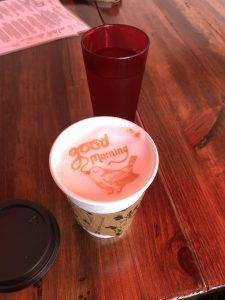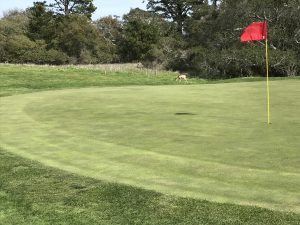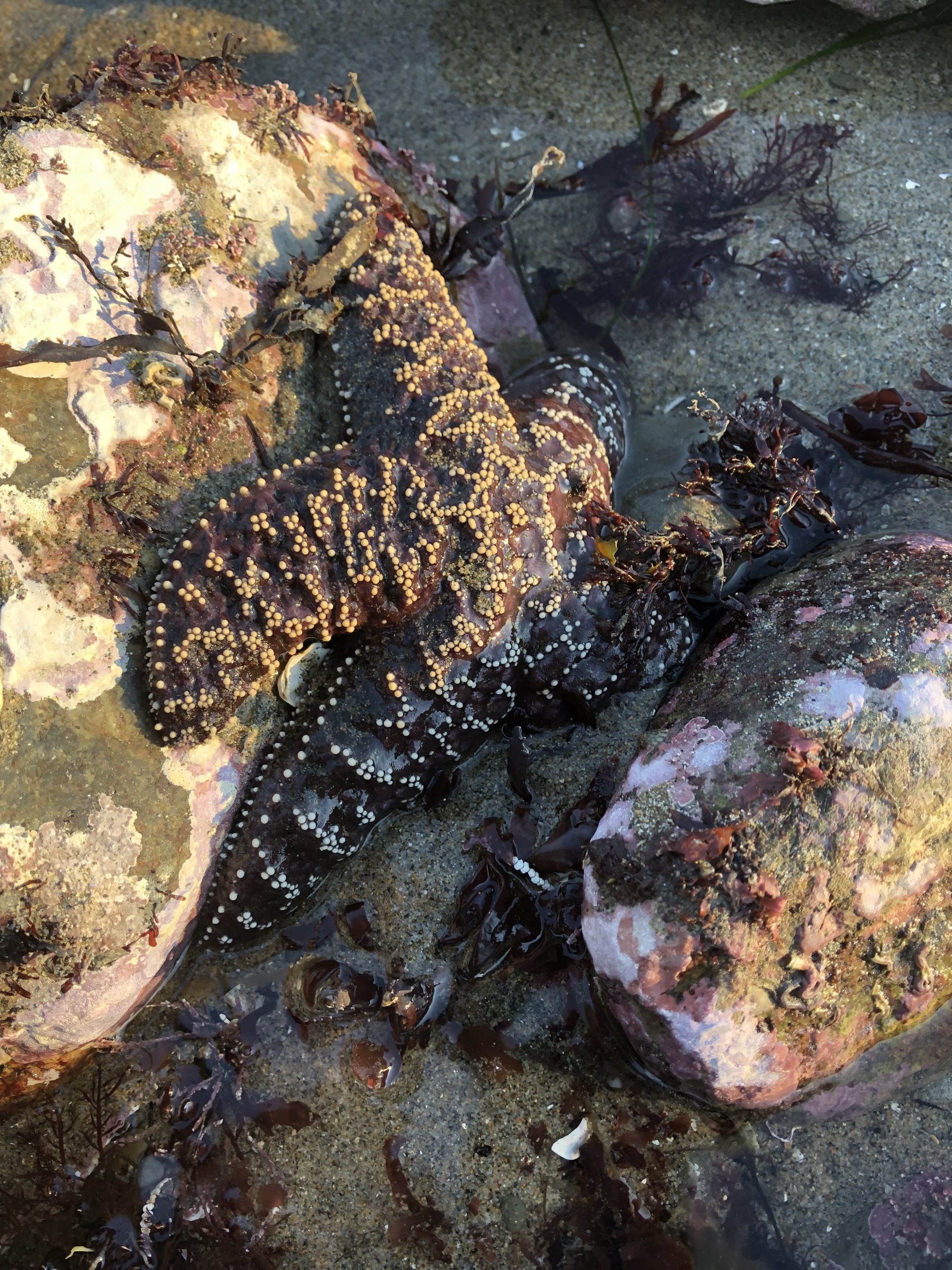
Admittedly, before I started my path down library lane, I was not a library user. My experience using the library was limited to a few sparse visits for research projects that produced disappointing results. My passion for working in the library field was ignited when I learned from a mama friend/alumna of the SJSU program that Library and Information Science could be so much more than what most people envision the traditional “library model” to be. The idea that librarians can turn this traditional paradigm on its head, create thousands of little tendrils that reach out to grab you from wherever you are, that is what excites me the most. To me, this describes Michael Stephens’ “Hyperlinked Library” model. Perhaps it’s a friendly octopus whose mission in life is to help you find something that you didn’t know you were looking for.
Now, I am working part-time as a library aide in my hometown’s public library. This position has afforded me the invaluable experience of witnessing operations from the ground level.  The organizational processes of circulation, the human interaction, learning something new every day, and knowing that I am a part of an institution that provides physical and mental refuge for people is the most fulfilling feeling. I have found what I had been searching for in a career. To paraphrase Brian Mathews in his 2012 paper, Think Like a Startup, the goal of library institutions is to help people become more successful. We, as library professionals, can define success in ourselves as we strive to serve others in this way.
The organizational processes of circulation, the human interaction, learning something new every day, and knowing that I am a part of an institution that provides physical and mental refuge for people is the most fulfilling feeling. I have found what I had been searching for in a career. To paraphrase Brian Mathews in his 2012 paper, Think Like a Startup, the goal of library institutions is to help people become more successful. We, as library professionals, can define success in ourselves as we strive to serve others in this way.
There are more and more examples of how libraries are implementing this innovative idea all over the world and embracing change, rather than creating rules.  One such example is the inspirational DOK Public Library, in Delft, Holland, seen on right. The Microsoft Surface table adjacent to the service desk is an interactive, technological tool that gives the user the power to add details to the story as they browse through a myriad of pictures of themselves and friends on a large, table-like screen. The grandchild to the beloved Pac Man table! This installation sends the message to users, “We want you to use this. We want to hear from you. You and your information are valued.”
One such example is the inspirational DOK Public Library, in Delft, Holland, seen on right. The Microsoft Surface table adjacent to the service desk is an interactive, technological tool that gives the user the power to add details to the story as they browse through a myriad of pictures of themselves and friends on a large, table-like screen. The grandchild to the beloved Pac Man table! This installation sends the message to users, “We want you to use this. We want to hear from you. You and your information are valued.”

Another example that made me say, “Wow!” is the Chicago Public Library (above). As one young customer states in CPL’s promotional video, “It’s fun here. All my friends are here. There’s a bunch of random stuff you can do.” The video includes young people making everything from 3-D models for a film, to dancing, making music and designing circuit boards. These opportunities for exploration, creation and encouraging inclusion and lifelong learning for all is, in the words of Michael Stephens, the “Heart of Librarianship” (2016).
All of these amazing ways libraries are doing things that traditionally libraries “don’t do” are beacons of light to swim toward for every library and its users.  But now having a little experience in a real public library world under my belt, I can see how librarians have become so disenchanted by having every great intention to create something wonderful squashed by roadblocks of funding and policy red tape (think of poor Artax, in the Swamp of Sadness from the NeverEnding Story, as a metaphor).
But now having a little experience in a real public library world under my belt, I can see how librarians have become so disenchanted by having every great intention to create something wonderful squashed by roadblocks of funding and policy red tape (think of poor Artax, in the Swamp of Sadness from the NeverEnding Story, as a metaphor).
In Casey and Stephens’ 2007 article, Turning ‘No’ Into ‘Yes,’ they describe such a phenomena as a very common experience:
Good employees who were once open to change and receptive to new ideas become entrenched in their positions and somewhere along the way become closed, curmudgeonly, and unreceptive to new ideas.
It is easy to become mired in workaday life, but Casey and Stephens challenge us to buck the muck and mire.  By offering opportunities to enhance library operations with a regular and consistent means to evaluate suggestions, small victories can be achieved:
By offering opportunities to enhance library operations with a regular and consistent means to evaluate suggestions, small victories can be achieved:
Get around the problem of “no” by creating an innovation workgroup. This team, charged with accepting new ideas and using the vertical-team format to give them all a fair and impartial review, can meet monthly to examine the newest crop of suggestions and ideas. (Casey & Stephens, 2007)
The idea that libraries can support “yes” and find creative ways to get around “no” is a surprising way for most people to think of what the library means. It challenges us information professionals to strive for excellence in creative problem-solving, in “Hyperlinking” users to the library in unexpected ways. In closing, I’ll include a quote from Michael Stephens’ Wholehearted Librarianship (2019), which I think sums up today’s plight of the librarian quite whimsically: “Please keep on learning, dreaming, and looking for ways you can make a difference in the lives of your users.”

References
Casey, M., & Stephens, M. (2007). Turning “no” into “yes.” Tame the Web. https://tametheweb.com/2007/05/01/turning-no-into-yes/
Chicago Public Library. (April 11, 2018). YOUmedia at CPL. [Screenshot & Video]. YouTube. https://www.youtube.com/watch?v=v8G4nnlgKmk
Mathews, B. (2012). Think like a start up. https://vtechworks.lib.vt.edu/server/api/core/bitstreams/77d2cb98-ddab-4543-9e47-b011819231b3/content
Stephens, M. (Nov. 7, 2011). Erik demonstrates surface & flikr app. [Screenshot & Video]. YouTube. https://www.youtube.com/watch?v=OCpY5zTv2Xo
Stephens, M. (2016). The heart of librarianship. ALA Editions. https://www.dropbox.com/s/gc9ecokb972xgil/HeartofLibrarianship.pdf?e=1&dl=0
Stephens, M. (2019). Wholehearted librarianship. ALA Editions. https://www.dropbox.com/s/jcg720db317y1fy/StephensWholehearted.pdf?e=1&dl=0
Still images by Laura Wecksler

Hello Laura,
After reading your awesome post about human interaction, I thought about the same thing when I work at my library as well. The realm of human interaction happens every day when working in the library. Whether you are a reference librarian or even a library page, patrons will come up and ask you anything. Sometimes we might not know the answer, but we try our best to figure out the question and find an answer for the patron. As I look into my day to day, some of the tenure supervisors that I work with, still have a mentality of saying “no” to the patrons at times. In my mind, I wish they can do better when working with patrons. Sometimes we do get patrons that are entitled or with attitude, but we still have to respect them and do our due diligence as supervisors when interacting with patrons. The mentality of saying “yes” can speak volumes about how the patron can be delighted when there is a solution for that question.
Hi Maverick,
First of all, thank you for taking the time to read my post! Secondly, I’m glad you are as enlightened as I on Stephens’ point of “Turning ‘No’ Into ‘Yes’.” It’s somehow a novel concept in library world. I’ve only been a library aide for a year, but as someone who is new to the profession, I can see that we (no matter what our role in the org. is) are the faces of the library to the public. When patrons approach you, to them, you are a librarian. So the ownness is on us to provide as much as is in our power to help the person in whatever way we can.
Hi Laura,
Thank you for this insightful post! I haven’t worked in a library setting recently, but I have noticed how employees in all work settings can become jaded and lose their enthusiasm as they become overworked and underappreciated. I recently did a paper for another class that talks about using design thinking as a leadership approach. I think this is a wonderful way to turn “NO” into a “Yes” as it focuses on using a team based approach to improve user experience. The input of employees from all levels is actively sought and all viewpoints are appreciated!
Hi @Roya,
Thank you for reading! I was just talking to the librarian on staff in the branch I work for today about how he was frustrated that the higher-ups wouldn’t ask for live musicians to attend their guitar classes because they were afraid of the Board or the Friends saying “no.” It’s discouraging and makes one feel that they have to “get in trouble” or bend the rules to create an innovative space. How are some libraries able to reach for the stars and others seem to be mired in the doldrums?
Hi @lauraw. That is a great question! I think it begins with visionary leadership. I remember doing a strategic plan for a library that primarily served homeless patrons. While the library had collaborated with partners in the community, and had done a decent job of addressing the needs of their homeless community, the staff were burnt out by safety concerns of unruly patrons, and patrons overdosing in their bathrooms. I kept thinking this library needs to hire a social worker like San Francisco public libraries do. I wish there were more dual MLIS/MS in social work programs (in my research, I only found one). I think a lot of urban libraries would benefit from librarians with social work expertise.
Hi @royaflin,
Wow, what a great experience to have had in the creation of a strategic plan for a library (it is such an abstract thing to me never having been a part of planning one). The issues with patrons you describe sound very similar to the one I work in now (the Downtown branch). There is an armed guard–no social workers–and police get called regularly or patrons get served with suspensions. I agree it should be part and parcel with librarianship and even think police officers should be trained in social work. It’s such a huge part of the job! I’m taking a “Serving Homeless Patrons in the Library” seminar now and hope to take away some interesting tactics that I can use in practice.
Hi @lauraw I wish I had actually taken part in an actual strategic plan, but this was for an assignment for INFO 204. I’d love to hear more about your seminar. Do you recommend it?
Oh right, 204! I’ll be happy to divulge once we’re farther along. It’s only just started. It’s a month long 1 unit course with Prof. Buckley. I took one of hers last semester and really liked the month-long schedule. It’s a great way to get in units if you can swing it.